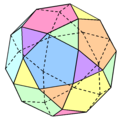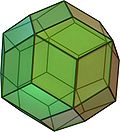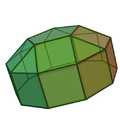Polyhedron

A polyhedron (polyhedra or polyhedrons if more than one) is a geometrical shape. It is a 3D shape with flat faces, and straight edges. Each face is a polygon surrounded by edges. Usually it is known by the number of faces, corners, or edges it has.
There are many groups of polyhedra, which can either be only a small set, or can be infinite. Prisms, pyramids, antiprisms, and bipyramids are groups of polyhedra.
A regular polyhedron has faces that are all the same, corners that are all the same, and edges that are all the same. A uniform polyhedron can have one or two kinds of its parts be all the same.
Definition[change | change source]
Two types of polyhedron are convex and concave. The edge connecting any two points of a convex polyhedron is inside the polyhedron. The line connecting two points of a concave polyhedron may go outside the polyhedron. The Platonic solids are regular convex polyhedra.
Mathematicians do not always agree on what makes a polyhedron. Some may only consider the convex polyhedra, and disregard the ones that are not convex. Some polyhedra are degenerate, meaning that when drawn as real objects, they look flat.
Naming[change | change source]
Usually, polyhedra are named by the number of faces they have. The first polyhedra are the tetrahedron, which is made of four triangles, pentahedron (five faces, can look like a four-sided pyramid), hexahedron (six faces, a cube if it is regular), heptahedron (seven faces) and octahedron (eight faces). Prisms, pyramids and other shapes can also be named after how many faces they have.
Other websites[change | change source]
- Eric W. Weisstein, Polyhedron at MathWorld.
- Making Polyhedra
- Polyhedra Pages
- Stella: Polyhedron Navigator – Software for exploring polyhedra and printing nets for their physical construction. Includes uniform polyhedra, stellations, compounds, Johnson solids, etc.
- The Uniform Polyhedra
- Virtual Reality Polyhedra – The Encyclopedia of Polyhedra
- Paper Models of Polyhedra Many links
- Paper Models of Uniform (and other) Polyhedra
- Interactive 3D polyhedra in Java Archived 2005-04-03 at the Wayback Machine
- World of Polyhedra Archived 2006-04-14 at the Wayback Machine – Comprehensive polyhedra in flash applet, showing vertices and edges (but not shaded faces)
- Polyhedra software, die-cast models, and posters
- Electronic Geometry Models – Contains a peer reviewed selection of polyhedra with unusual properties
- Symmetry, Crystals and Polyhedra Archived 2017-02-24 at the Wayback Machine
- uniform solution for uniform polyhedra by Dr. Zvi Har'El Archived 2011-05-20 at the Wayback Machine
- Java applet with the use of kaleido Archived 2007-08-18 at the Wayback Machine
- Origami Polyhedra – Models made with Modular Origami
- Polyhedra Collection[permanent dead link] – Various virtual and physical polyhedra models








